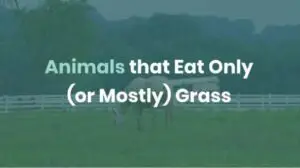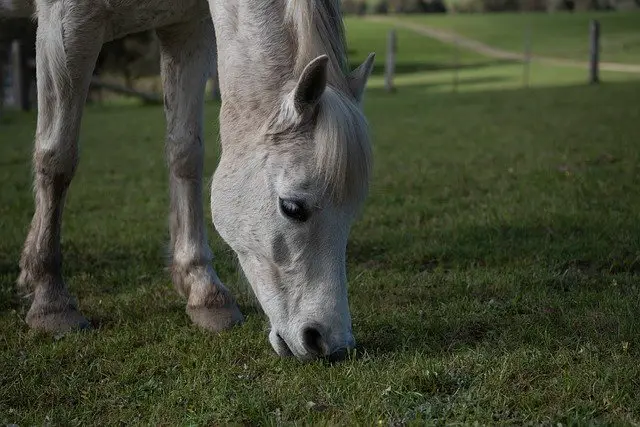
Herbivores are animals that eat mostly plants. There is also a type of herbivore that eats mostly grass for its food.
In this post, we will look at animals that eat grass, or mostly grass in their diet. You will learn what animals that eat grass are called, examples of animals that eat mostly grass, as well as answers to some other common questions about grass-eating animals.
Contents
- What are Herbivores that Eat Grass Called?
- What Animals Eat Grass?
- What Eats Grass in the Savanna?
- Farm Animals that Eat Grass
- What Animal Eats the Most Grass?
- What Animals Mainly Eat Grass?
- Which Animals Eat Grass and Leaves?
- Do Grasshoppers Eat Grass?
- Do Squirrels Eat Grass?
- Conclusion
What are Herbivores that Eat Grass Called?
Herbivores that eat grass are called graminivores or are commonly referred to as grazers. (Remember that animals that eat only plants are called herbivores.

The word graminivore is derived from the two Latin words which mean “grass” and “eat”. This is where the term grazing also comes from. To graze therefore means to eat grass.
“Grazers” are a type of herbivore and are in contrast to “Browsers” which are also herbivores. Browsers eat leaves, fruits and things up higher. Grazers on the other hand eat grass, which is lower down.
(You can learn more about herbivores and the different types at Herbivorous Animals)
What Animals Eat Grass?
Here are animals that eat primarily grass in their diet, and are thus classified as Graminivores. For a longer list of animals that eat grass but are not necessarily graminivores, see our:
- 20 Grass Eating Animals
- Small Animals that Eat Grass
- What Animals Eat Grass in the Forest
- What Insects Eat Grass
Video – Animals that only (or mostly) eat grass (Graminivores or Grazers)
Cows
Cows are animals that graze and eat a lot of grass. They do browse as well and eat plants.

In dairy settings, they don’t eat as high of a percentage of grass in their diet, since they are fed grains and in addition to hay and grass.
Bulls
Bulls are similar to the cows mentioned above. Cattle eat grass as their main source of food.
Horses

Horses are also in the group of farm animals that eats grass. Horses love to graze and eat grass and hay. They are also able to eat fruits and vegetables if that is available to them.
Hippos
Hippos eat mostly grass that is found near water, and some water plants. Hippos will eat up to 80 pounds or more of grass per day!
Bison
Bison are grazers and eat mostly grass and grass-like plants called sedges.
Zebras
Zebras eat almost only grass in their diet, with 90% of their diet being grass. They also eat leaves and twigs as well as shrubs when grass is not available.
Geese
Unlike most aquatic birds, instead of eating water plants and animals, they eat food from the land. You can usually see geese grazing around in the grass in groups.
Sheep
Sheep graze most of the day, eating grass and weeds.
Donkeys
Donkeys eat mostly grass in the wild. They will also eat shrubs and desert plants.
Grasshoppers
Grasshoppers are insects that eat grass, plant stems, and leaves.
Red Kangaroo
The Red Kangaroo grazes and eats mostly grass. They will also eat some leaves.
Wildebeests
Wildebeests are mostly grazers, eating mainly sweet grass.
Giant Pandas
Giant pandas feed 99% on bamboo, which is a type of grass of the Poaceae family. They are an animal that eats only grass, or almost mostly grass.
Rabbits
Rabbits are small animals that eat grass, vegetation, and things from plants. Grass and hay make up the majority of the rabbit’s diet.
Capybara
Capybaras are vegetarians. Grass makes up 80% of their vegetarian diet.
Green Sea Turtle
The Green Sea Turtle’s primary source of food is seagrass and algae.
What Eats Grass in the Savanna?
The Savana has a multitude of plant-eaters, but it’s still able to support all of these different herbivores in the same area. One reason is that the Savanna has over 80-100 different grass species. All of these species of grass help to feed the at least 16 species of grass-eating grazers found there.
The animals that eat this grass in the Savanna are the antelopes, zebras, wildebeests, impalas, elephants, cattle, and buffalo.
Farm Animals that Eat Grass
Some farm animals that eat grass include horses, cows, goats, sheep, chickens, turkeys, and donkeys. You can learn about the main animals that eat grass on a farm at Farm Animals that Eat Grass.
For large areas, cattle are probably the best for eating and managing extra grass. For smaller areas, sheep are the best option for managing grass.
What Animal Eats the Most Grass?
Hippos eat more grass than any other grass-eating animal. An adult hippo will eat 80 pounds or more of grass per day!
Other animals that eat a lot of grass, but not nearly as much as the hippo, are horses and cattle.
Horses will eat 16-32 pounds of grass per day. Bison and cows will eat around 24 pounds of grass per day.
What Animals Mainly Eat Grass?
Some animals that mainly eat grass are Cows, Bulls, Horses, Hippos, Bison, Zebras, Geese, Sheep, Donkeys, Grasshoppers, Red Kangaroos, Wildebeests, Giant Pandas, Rabbits, Capybaras, Wildebeests, and Green Sea Turtles.
Which Animals Eat Grass and Leaves?
Some animals that eat both grass and leaves are zebras, kangaroos, grasshoppers, deer, camels, beavers, and elephants. All of these are herbivore animals that eat both grass and leaves in their diets.
Do Grasshoppers Eat Grass?
Grasshoppers are herbivores. Grasshoppers eat grass as one of their main foods, as well as leaves, flowers, plants, seeds and stems.
Do Squirrels Eat Grass?
Squirrels don’t usually eat grass. They will on occasion, but usually squirrels are more interested in eating grass seed. This is because the main foods that squirrels eat are nuts and seeds.
Conclusion
These were animals that all eat mainly or almost only grass. These grass-eating animals are called Graminivores and are known as grazers. This is because they graze the land eating grass.
Lance has been passionate about the plant-based diet and we have been following a whole food plant-based diet for over 5 years. We focus on health, natural healing, weight management, animal rights, and the health of the planet and environment by focusing on whole plant-based foods and sustainable practices.
Learn more at the About Me page and follow on social media at the links below.






